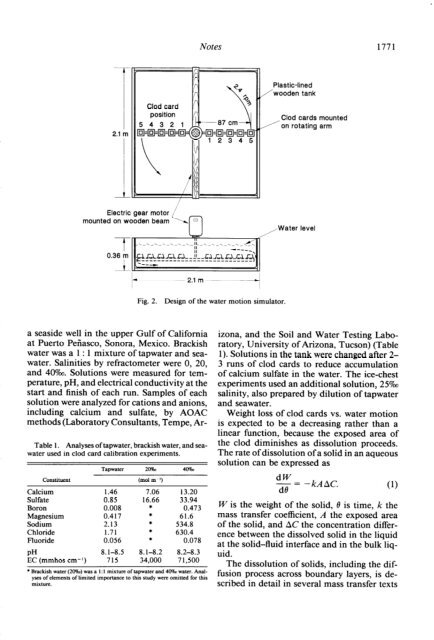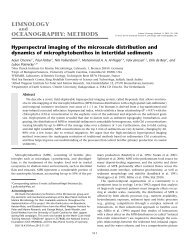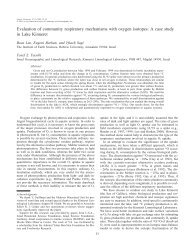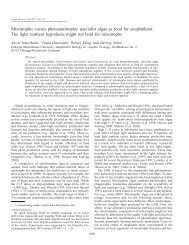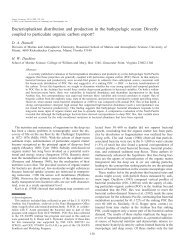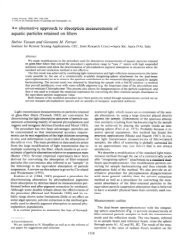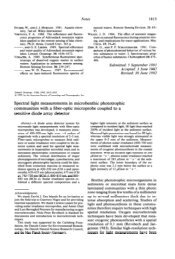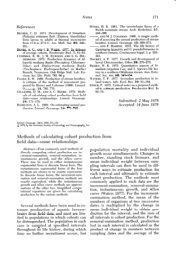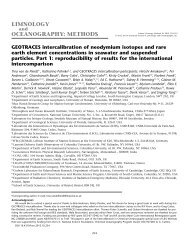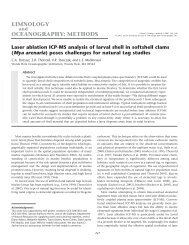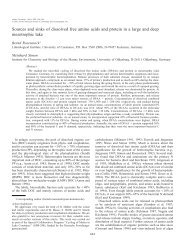Download - ASLO
Download - ASLO
Download - ASLO
You also want an ePaper? Increase the reach of your titles
YUMPU automatically turns print PDFs into web optimized ePapers that Google loves.
Notes 1771<br />
T<br />
2.1 m<br />
mounted<br />
arm<br />
mounte~~~~a level<br />
k- 2.1 m 4<br />
Fig. 2. Design of the water motion simulator.<br />
a seaside well in the upper Gulf of California<br />
at Puerto Pefiasco, Sonora, Mexico. Brackish<br />
water was a 1 : 1 mixture of tapwater and seawater.<br />
Salinities by refractometer were 0, 20,<br />
and 407~. Solutions were measured for temperature,<br />
pH, and electrical conductivity at the<br />
start and finish of each run. Samples of each<br />
solution were analyzed for cations and anions,<br />
including calcium and sulfate, by AOAC<br />
methods (Laboratory Consultants, Tempe, Ar-<br />
Table 1. Analyses of tapwater, brackish water, and seawater<br />
used in clod card calibration experiments.<br />
Constituent<br />
Tapwater 20%3 40%<br />
Calcium 1.46 7.06 13.20<br />
Sulfate 0.85 16.66 33.94<br />
Boron 0.008 * 0.473<br />
Magnesium 0.417 * 61.6<br />
Sodium 2.13 * 534.8<br />
Chloride 1.71 * 630.4<br />
Fluoride 0.056 * 0.078<br />
PH 8.1-8.5 8.1-8.2 8.2-8.3<br />
EC (mmhos cm-‘) 715 34,000 71,500<br />
* Brackish water (20%~) was a I : 1 mixture of tapwater and 40% water. Analyses<br />
of elements of limited importance to this study were omitted for this<br />
mixture.<br />
(mol<br />
m-l)<br />
izona, and the Soil and Water Testing Laboratory,<br />
University of Arizona, Tucson) (Table<br />
1). Solutions in the tank were changed after 2-<br />
3 runs of clod cards to reduce accumulation<br />
of calcium sulfate in the water. The ice-chest<br />
experiments used an additional solution, 25o/oo<br />
salinity, also prepared by dilution of tapwater<br />
and seawater.<br />
Weight loss of clod cards vs. water motion<br />
is expected to be a decreasing rather than a<br />
linear function, because the exposed area of<br />
the clod diminishes as dissolution proceeds.<br />
The rate of dissolution of a solid in an aqueous<br />
solution can be expressed as<br />
dW<br />
- = -kAAC.<br />
d6<br />
W is the weight of the solid, 8 is time, k the<br />
mass transfer coefficient, A the exposed area<br />
of the solid, and AC the concentration difference<br />
between the dissolved solid in the liquid<br />
at the solid-fluid interface and in the bulk liquid.<br />
The dissolution of solids, including the diffusion<br />
process across boundary layers, is described<br />
in detail in several mass transfer texts


